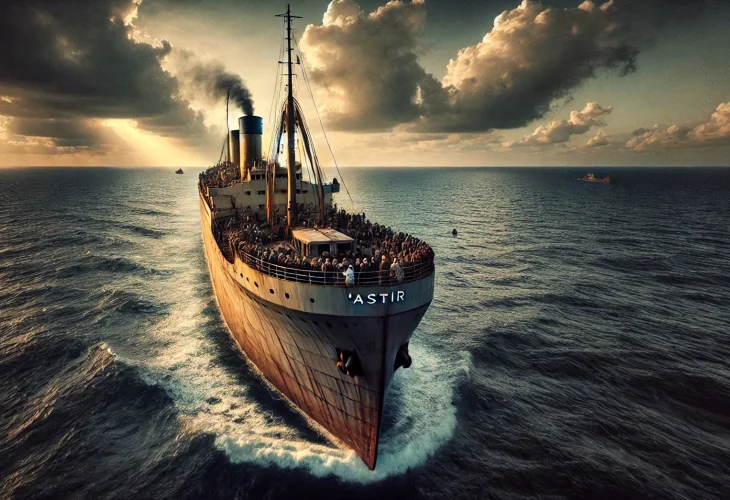Lost at Sea: The Struggle for Safe Passage to Israel
Conditions on the ship worsened. Some passengers were in dire straits, while others clung to sanity. A couple decided to marry. Crumbs of stale bread were collected, kneaded with water, and fried in a pan. An anonymous passenger contributed jam to spread on the prized creation, and thus the wedding took place.

Before the outbreak of World War II, various Jewish organizations attempted to organize clandestine immigration to the Land of Israel. In March 1939, months prior to the war's start, Betar operative Avraham Stavsky managed to lease a ship. The ship, named "Astir," was rented in Greece. A private company in Piraeus had purchased it from a Danish factory over forty years earlier, and it was built at the end of the 19th century. "Astir" was a coal carrier, and renting it cost Stavsky a significant amount. The massive coal hold was converted to transport people. Bunks were installed along the walls, and it was divided into two large halls: one for men and one for women.
Word of the ship sailing to the Land of Israel spread across Europe. Hundreds flocked to the port of Reni in Romania (now in Ukraine): Romanian residents, Jewish refugees from Danzig (Gdansk), which was then free, and many refugees from Nazi Germany and Austria. The refugees were taken to boats in the dead of night, which approached the ship, and then the ship's cranes, originally used for coal lifting, were operated. People were chained to the crane, hoisted, and lowered 9 meters beneath the deck into their designated hall. They were told not to ask questions, and within days they would reach their destination.
The ship's commander, an activist named Sander, was very strict, believing discipline was essential. He separated families: women and children on one side, men on the other. He forbade complaints or excessive questioning. Passengers found themselves in complete darkness, groping toward their bunks. Rain seeped through cracks and dripped on the heads of those crowded on the bunks. They were prohibited from surfacing after dark, among other draconian rules. They learned the ship had about a thousand people onboard, though its capacity couldn't exceed 500.
The refugees agreed to endure anything, so long as they reached the Land of Israel within a few days, as promised. They arrived off the coast of Rishon LeZion within ten days, but the commander awaited a signal from underground agents that never came. Reluctantly, he returned to the open sea. The ship began aimless circles in the Mediterranean. Food and water rations dwindled, and the commander's strictness only grew. People fainted from lack of water and food. A young girl threatened suicide, constantly supervised by her mother and sister. Shouts emerged from the women's hall, and their male relatives were distraught, but the commander refused to connect the two sections.
Filth onboard increased, mice grew in number, and for unknown reasons, the commander forbade harming them. Rumors spread of two German agents among the passengers extracting confessions about valuable assets left in Germany, leading everyone to suspect one another. The captain decided he couldn't endure the ordeal longer, docked in Greece, and fled... The ship's commander hired a new captain, who escaped within a week. The third captain agreed to continue the horrific journey.
Meanwhile, conditions worsened. Some passengers reached extreme distress, while others tried to maintain sanity. Among them was a couple who decided to marry. Stale bread crumbs were gathered from across the ship, kneaded with water, and fried. An anonymous passenger offered jam to spread, and thus the wedding was celebrated.
After weeks of wandering at sea, the ship neared the shores of Israel again. Near Herzliya, the British captured it, dragged it to Haifa's port, supplied it with food and drink for five days, and sent it out to sea yet again! About two months after its departure, British MP Weizmann raised a question to Colonial Secretary MacDonald: would Britain pity the Jewish refugees fleeing Nazi terror? MacDonald replied with a negative. The ship continued drifting in the Mediterranean expanses. On June 28, it neared the shores of Ashkelon, where the British captured it again and detained all its passengers. Their condition was so dire the British had to release them, and their number was deducted from the immigrants the British permitted entry.
The ship's captain was sentenced to nine months in prison, and the sailors were also imprisoned. Avraham Stavsky, recently acquitted of Haim Arlozorov's murder, was killed aboard the Altalena by "Hagana" gunfire. The ship's commander, Sander, was ousted from the Irgun and stripped of his rank. He later became the victim of a lynching in Tel Aviv's streets by angry passengers who remembered his harsh conduct during the bleak journey. He was severely beaten but survived.

